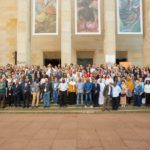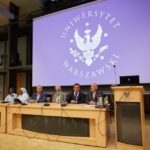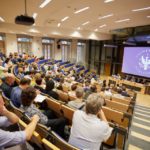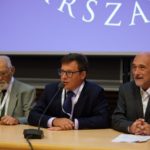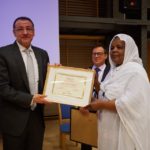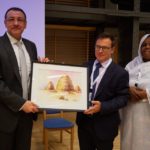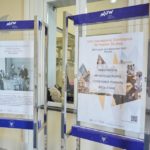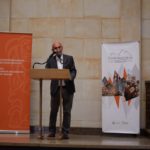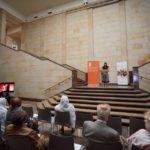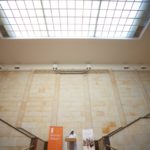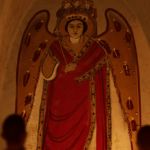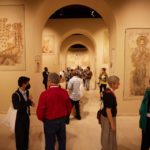The 15th International Conference for Nubian Studies has come to an end. This scientific event, the largest in this field of research, is held every four years in one of the leading research centers. This year, at the University of Warsaw, it brought together more than 200 participants from nearly 20 countries.
Nubia, the subject of Nubiological research, is a historical region covering the area of today’s Sudan and southern Egypt. Research on Nubia reveals a fascinating history spanning many thousands of years of statehood, as well as the enormous cultural richness, complexity and diversity of societies in the region. They are an important part of the rapidly growing research on the heritage of Africa, hailed in the media as “the continent of the future.”
A significant contribution to these studies has been made by Polish research expeditions, which are involved in the study of Nubian archaeology from the Paleolithic to the modern period. Nubia is the cradle of one of Africa’s oldest great civilizations, that of the kingdom of Kush (from around 2500 BCE). Beginning in the 8th century BCE, the Kushite rulers also reigned over Egypt as the XXVth Dynasty, which remained in power for nearly a century. Among Sudan’s most spectacular monuments are the pyramids of the Kushite kings and queens, erected over a period of nearly a thousand years, until the 4th century CE. With the advent of Christianity, which arrived in this region 400 years earlier than in Poland, three kingdoms called Nobadia, Makuria and Alwa prospered in Nubia. They left behind impressive ruins of cities, palaces, fortresses with massive walls, as well as churches and monasteries. Unique wall paintings from the cathedral in Faras, the capital of Nobadia, can be admired today at the National Museum in Warsaw. It is the only collection of medieval Nubian painting outside Sudan. Polish researchers were granted the right to export these relics during the so-called Nubian Campaign, after saving them from the rising waters of Lake Nasser in the wake of the construction of the Aswan High Dam.
– Since then, Polish archaeologists have been constantly present in Sudan, achieving outstanding scientific results – says Dr. Obłuski. Their work is supported by the PCMA UW Research Centres in Khartoum and Old Dongola.
Held every four years, the International Conference for Nubian Studies is the most important scientific event in the field. At this year’s conference at the University of Warsaw, the Nubiological community celebrated its 50th anniversary. In 1972, the International Society for Nubian Studies (ICNS) was established at a conference that also took place in Poland, at the National Museum in Warsaw. Today, the ICNS has several hundred members from more than 20 countries around the world.
At the inauguration of the conference in the auditorium of the Old University Library, the participants were welcomed by Prof. Sambor Grucza, Vice Chancellor of the University of Warsaw. Speeches were also delivered by Ms. Ghalia Garelnabi, General Director of the Sudanese National Corporation for Antiquities and Museums, Dr. Stefan Jakobielski, the doyen of Polish Nubiology from the Institute of Mediterranean and Oriental Cultures of the Polish Academy of Sciences, Prof. Adam Łajtar of the Department of Epigraphy and Papyrology of the Faculty of Archaeology of the University of Warsaw, and Dr. Artur Obłuski, director of the Polish Centre of Mediterranean Archaeology at the University of Warsaw and president of the ICNS.
The ceremony was also attended by representatives of the Embassy of the State of Qatar in Warsaw, Mr. A-Rahim Mohd Abu-Khadija, Embassy Counselor, Mr. Omar Ali Al-Ali, Second Secretary, and Mr. Ammar Hamid, Analyst. To their hands, Dr. Obłuski and Ms Garelnabi presented a diploma of appreciation from the International Society for Nubian Studies to the State of Qatar for its support of archaeological research and preservation of Sudan’s cultural heritage within the framework of the Qatar-Sudan Archaeological Project (QSAP) implemented by Qatar Museums. They also received a watercolor depicting the archaeological site of Old Dongola, painted by Iryna Melnyk of the PCMA UW, an artist and conservator originally from Ukraine.
During a welcome cocktail at the National Museum in Warsaw, the guests were welcomed on behalf of the Museum by Dr. Aleksandra Sulikowska-Bełczowska, Curator of the Collection of Ancient and Eastern Christian Art; Prof. Adam Łajtar and Ms. Ghalia Garelnabi also addressed the assembled guests. Especially for the conference guests, the Museum opened the Faras Gallery, as well as the galleries of Medieval Art and 19th Century Art. Guests were also able to take a virtual tour (in VR headsets) of the Nubian monasteries of Old Dongola and Ghazali reconstructed as part of the Virtual Nubia project.
At this year’s conference, Artur Obłuski was for the second time elected president of the ICNS, while the long-time director of the PCMA UW expedition in Old Dongola and participant of the Faras expedition, Dr. Stefan Jakobielski, became the honorary member of the Society’s Council. The ICNS also decided that 50 years after its establishment it would be officially registered in Poland. The venue for the next conference was also announced – in 2026 it is to be held in Munich.
This conference was special not only because of the anniversary. At the invitation of the University of Warsaw, it was attended by a record number of about 50 participants from Sudan, who work with foreign expeditions and conduct research under the aegis of Sudanese universities. Their arrival allowed further deepening of international cooperation and fruitful exchange of information. In addition to presentations of the latest archaeological discoveries, among the discussed issues were applications of new technologies in research and conservation, social responsibility and cooperation in archaeology, and involvement of local communities in the protection and management of cultural heritage.
The conference was organized by the PCMA UW thanks to funding from the Ministry of Education and Science for the task “Internationalization of research of the University of Warsaw Archaeological Research Centers”. The organization of the conference also received support from the University of Warsaw program “Excellence Initiative – Research University” (IDUB).
-
Participants of the 15th ICNS in front of the National Museum in Warsaw / Uczestnicy 15.ICNS przed Muzeum Narodowym w Warszawie (Fot. K. Szczęsny)
-
Inauguration of the 15th ICNS in the Old Library of the University of Warsaw / Otwarcie konferencji w starej BUW (Fot. K. Szczęsny)
-
Inauguration of the 15th ICNS in the Old Library of the University of Warsaw / Otwarcie konferencji w starej BUW (Fot. K. Szczęsny)
-
Prof. Sambor Grucza, Vice Chancellor of the University of Warsaw at the inauguration of the 15th ICNS in the Old UW Library / Prof. dr hab. Sambor Grucza, Prorektor UW ds. Współpracy i Spraw Pracowniczych podczas otwarcia konferencji w starej BUW (Fot. K. Szczęsny)
-
Dr. Stefan Jakobielski, Dr. Artur Obłuski and Prof. Adam Łajtar at the inauguration of the 15th ICNS in the Old Library of the University of Warsaw / Dr hab. Stefan Jakobielski, Dr hab. Artur Obłuski i prof. Adam Łajtar podczas otwarcia konferencji w starej BUW (Fot. K. Szczęsny)
-
Dr. Mahmoud El-Tayeb and Ms Ghalia Garelnabi at the inauguration of the 15th ICNS in the Old Library of the University of Warsaw / Dr. Mahmoud El-Tayeb and Ms Ghalia Garelnabi a podczas otwarcia konferencji w starej BUW (Fot. K. Szczęsny)
-
Dr. Obłuski and Ms Garelnabi present representatives of the Embassy of the State of Qatar with a diploma of appreciation from the International Society for Nubian Studies to the State of Qatar / Dr Obłuski i Pani Garelnabi wręczają przedstawicielom Ambasady Państwa Katar dyplom uznania od Międzynarodowego Towarzystwa Nubiologicznego dla Państwa Katar (fot. K. Szczęsny)
-
Dr. Obłuski and Ms Garelnabi present representatives of the Embassy of the State of Qatar with a painting of Old Dongola / Dr Obłuski i Pani Garelnabi wręczają przedstawicielom Ambasady Państwa Katar obraz przedstawiający widok Starej Dongoli (fot. K. Szczęsny)
-
Information on conference events / Informacje o wydarzeniach konferencyjnych (fot. K. Szczęsny)
-
Prof. Adam Łajtar at the welcome cocktail at the National Museum in Warsaw / Prof. Adam Łajtar podczas koktailu powitalnego w MNW (fot. K. Szczęsny)
-
Dr. Aleksandra Sulikowska-Bełczowska, welcomes the 15thICNS participants at a cocktail at the National Museum in Warsaw / Dr. hab. Aleksandra Sulikowska-Bełczowska,wita uczestników konferencji podczas koktailu powitalnego w MNW (fot. K. Szczęsny)
-
Ms Ghalia Garnelnabi addresses the 15thICNS participants at a cocktail at the National Museum in Warsaw / P. Ghalia Garnelnabi przemawia do uczestników konferencji podczas koktailu powitalnego w MNW (fot. K. Szczęsny)
-
Information on the presentation of Virtual Nubia / Informacje o prezentacji rekonstrukcji 3D ‘Wirtualna Nubia’ (fot. K. Szczęsny)
-
Conference participants using VR headsets during the presentation of Virtual Nubia / Uczestnicy konferencji podczas wirtualnego zwiedzania (fot. K. Szczęsny)
-
Conference participants using VR headsets during the presentation of Virtual Nubia / Uczestnicy konferencji podczas wirtualnego zwiedzania (fot. K. Szczęsny)
-
Stara Dongola – Wywyższenie Archanioła Michała przez Trójcę Makurycka; fragment rekonstrukcji 3D (www.virtualnubia.uw.edu.pl)
-
Stara Dongola – krypta arcybiskupa Georgiosa z tekstami greckimi, koptyjskimi i staronubijskimi na ścianach; fragment rekonstrukcji 3D (www.virtualnubia.uw.edu.pl)
-
Conference participants visiting the Faras Gallery / Uczestnicy podczas zwiedzania Galerii Faras (fot. K. Szczęsny)
-
Conference participants visiting the Faras Gallery / Uczestnicy podczas zwiedzania Galerii Faras (fot. K. Szczęsny)
-
Bust of Prof. Kazimierz Michałowski at the the Faras Gallery / Popiersie prof. Kazimierza Mi Galerii Faras (fot. K. Szczęsny)



